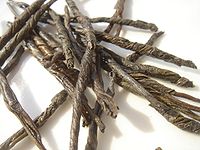
Photo from wikipedia
The effect of Camellia sinensis (green tea) on the growth of Acanthamoeba castellanii trophozoites was examined using a microplate based-Sulforhodamine B (SRB) assay. C. sinensis hot and cold brews at… Click to show full abstract
The effect of Camellia sinensis (green tea) on the growth of Acanthamoeba castellanii trophozoites was examined using a microplate based-Sulforhodamine B (SRB) assay. C. sinensis hot and cold brews at 75% and 100% concentrations significantly inhibited the growth of trophozoites. We also examined the structural alterations in C. sinensis-treated trophozoites using transmission electron microscopy (TEM) and scanning electron microscopy (SEM). This analysis showed that C. sinensis compromised the cell membrane integrity and caused progressive destruction of trophozoites. C. sinensis also significantly inhibited the parasite's ability to form cysts in a dose-dependent manner and reduced the rate of excystation from cysts to trophozoites. C. sinensis exhibited low cytotoxic effects on primary corneal stromal cells. However, cytotoxicity was more pronounced in SV40-immortalized corneal epithelial cells. Chromatographic analysis showed that both hot and cold C. sinensis brews contained the same number and type of chemical compounds. This work demonstrated that C. sinensis has anti-acanthamoebic activity against trophozoite and cystic forms of A. castellanii. Further studies are warranted to identify the exact substances in C. sinensis that have the most potent anti-acanthamoebic effect.
Journal Title: International Journal for Parasitology: Drugs and Drug Resistance
Year Published: 2020
Link to full text (if available)
Share on Social Media: Sign Up to like & get
recommendations!